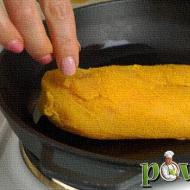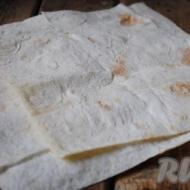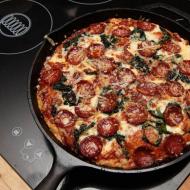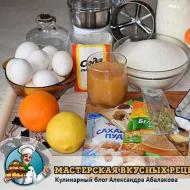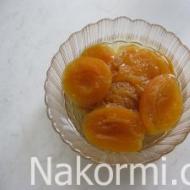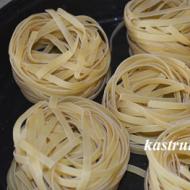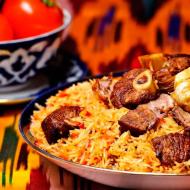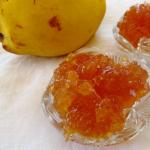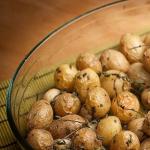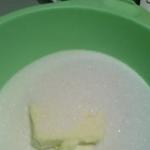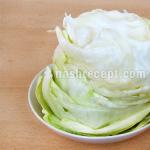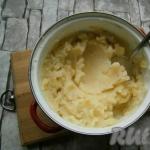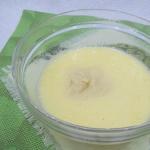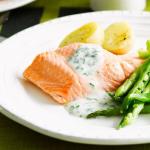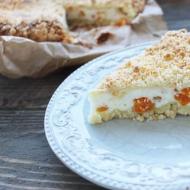
Serbian dishes. Serbian cuisine: hot dishes. Recipes of Serbian cuisine. Dishes for the holidays. National New Year recipes
Serbs are solid guys, and therefore they never miss breakfast, lunch, or dinner, happily combining them with a coffee break, which they drink here instead of water and tea. Dinner in Serbia is always the heaviest, which is why people like to slam the refrigerator door at night fast they will find brothers in spirit here.
Serbian cuisine is the meat richness of Central Europe combined with the vegetable freshness and spice of the Mediterranean. We have compiled our subjective top Serbian delicacies , which perhaps motivates you google tickets for the next plane to Belgrade.
Meat with meat
80% of Serbian food is meat, from which dozens of types of sausages, cutlets and chops are made. For example, the most important dish is cevapchichi (ћevapchiћi) - juicy pork sausages (sometimes wrapped in bacon), which can be sharpened straight from the grill on every big street in any city. It is customary to stuff such a sausage into a bun similar to a cheburek, sprinkle generously with herbs, onions and paprika, eat it greedily in 10 seconds and then walk around with a burnt mouth for half a day.
The main Belgrade feature isKarađorđeva schnitzla (Kara?or?eva šnicla). Schnitzla is a thick pork sausage stuffed with kajmak (fermented salted milk foam), fried and breaded. Any self-respecting Serbian kafana (that’s the name of a traditional local tavern) will serve it with fries and tartar. The main thing to remember when ordering is that the Serbian portion is two or even three times larger than the standard Belarusian portion.
Serbian answer to hamburger -Pljeskavica(pieskavica), a large minced pork cutlet grilled over charcoal. Eat it with Serbian proja bread or just plain, wash it down with tasteless Serbian yoghurt - the best friend of a tourist who wants to try all the meat goodness without cracking.
Be sure to try itcookie- if only because in Serbian this is what they call a huge piece of spicy pork, roasted on a spit. With such a variety of meat, our favorite kebabs on skewers are perceived by locals as fast food, which does not deserve special attention.
Did you eat jamon in Barcelona? So, you will appreciate andprosciutto- dried meat, which is cut directly from an impressive ham hanging from the ceiling. Prices, like everything else in Serbia, make you wonder - have you been shortchanged in your favor?
Lovers of cabbage rolls will appreciate their Balkan counterpart -sarmu( sarma ) , which is made not from fresh, but from sauerkraut. Fatty, salty, heavy sarma is simply created to treat hangover, and in Serbia you will get to know it closely (but more on that below).

Serbian snack
The Serbs have a great variety of salads: warm, moderately humid - vegetables come out like crazy. We recommend trying the classics -Shopska salad (Shopska Salata), a mix of cucumbers, tomatoes, peppers and grated cheese with lemon, chopped into giant pieces. By the way, if you want to go to Serbia for the New Year, they also have Olivier and it’s called “salata ruska”.
Connoisseurs of grandma's sunsets will be able to have a blast in Serbia by purchasingaivara (ajvar). This is fried and baked red paprika, which is twisted with tomatoes. In fact, it is the most delicate lecho, it is spread on bread, meat, or simply eaten with spoons in the morning. Every Serb firmly believes that the most correct ajvar in the country is prepared by his mother.
Another wonderful invention of the Serbs is the idea of baking peppers, salting, pickling, rolling in a jar and serving under the name “baked paprika" Due to the fact that it is smoked over an open fire, you might think that the paprika is rotten, but don’t panic - everything is as intended!

Baking and sweets
Baking in Serbia is not a holiday food, but an everyday food. From 7 am in any bakery(baker) you can take it pita- a strip of puff pastry with different fillings. The most important, naturally, is meat, but there are a million options - from cherries to spinach. The portion is enough to fill you up for the whole day, so be careful - you still have a lot to try.
Good breakfast option -burek, a layer cake with different fillings, the portion of which looks like a quarter of a large frying pan, and the gluttony is just off the charts.
Desserts in Serbia are almost like in Turkey: honey, nuts, dried fruits, thick dough.
If you still think that tarragon is the green soda from childhood, then you definitely need to go to Serbia. One of the main desserts here ispotica, roll with tarragon, which is scientifically called tarragon.
Be sure to eat a piece of the complex piegibanicawith walnuts, sour cream, cottage cheese and apples, raisins and poppy seeds. Traditional advice to everyone who travels to the Balkans: don’t be greedy and take one for two!
Don't pass by pancakes with walnuts and millet -executioner. Even if you can’t stand porridge since kindergarten, this sweet happiness will go great.

Alcohol
Serbs have a special relationship with alcohol - they drink a lot here and with pleasure. The calling card of Serbia is fruit moonshine.brandy,which is driven out of everything,what grows in the garden. The strongest plum, but also other varieties (honey, quince, cherry, raspberry, pear) are planted in the sleigh very quickly. Although rakia is drunk slowly, thoughtfully and with gusto, already a couple of hours after the start of the evening in the kafan, the number of people dancing on the tables goes through the roof.
In order to dance and not be afraid of spilling brandy, the Serbs invented special dishes - chokanchici - glass bubbles with a thick bottom that you can take in your hand and anneal without fear of dousing your neighbor. By the way, good rakia costs no less than € 6-7 perhalf liter.
Beer in Serbia is unremarkable; locals prefer thin lagerJelen, pilsner Lavor some kind of craft.
Home Serbian delicacy -blackberry wine (kupinovo vino). It contains only 4 degrees, not an ounce of chemicals and tastes like blueberriesFruittella. Serbs, by the way, usually don’t speak toast, limiting themselves to the capacious “živeli” - an analogue of our “budzma”.
Considering that the working day usually starts very early, by 16.00 most people are already free and ready to hang out in establishments that are incredibly democratic in Serbia. Often, the owner of a store simply places an umbrella and a couple of plastic chairs on the street - this is already an option to drink lemonade or a cup of real coffee and chat about life.
And in cafes and restaurants it’s absolutely good - the price tag causes a “wow” effect, people leisurely enjoy huge portions, the waiters behave like your best friends. A waiter in Serbia is not a garçon or a service staff, but a hospitable host who will do everything to provide tastier food. So remember: hedonists don't lose weight. Especially in Serbia.
Photo: mimiskingdom.com; Facebook community of Comunale restaurant
Travelers, having arrived in Serbia, from the first minutes fall in love with the amazing landscapes of the Balkan territory, and from the second - with the local cuisine. Traditional Serbian cuisine has developed under the influence of the gastronomic characteristics of Hungary, Bulgaria and Turkey. This unique culinary “fusion” explains the heterogeneity and variety of dishes prepared by the Serbs.
Serbian chefs borrowed the peculiarities of making sweets and pastries from the Turkish people. From Hungary they adopted the method of preparing dishes based on pork fat - lard. But the biggest influence on the Serbian recipe was the Bulgarians. According to their traditions, Serbia developed a special love for vegetables. They are always served - for breakfast, lunch or dinner, on their own or as part of a dish.
Vegetables are not only put in salads, but also boiled, stewed, baked, used as a filling and grilled. The meat tastes of the Serbian people also came from the Bulgarians. They left behind many original names for meat and fish dishes, which sound very interesting and unusual: pleskavitsa, zelyanitsa, dzhuvech, chorba, palanchiki.
Features of national Serbian cuisine
Serbian food- simple and satisfying. It is easily accepted by Ukrainians and Russians, as it is quite unpretentious and is famous for its purity of taste and the absence of specific additives. As in any place in the Balkans, vegetarianism and diets are not held in high esteem in Serbia, so people here like to eat tasty and satisfying food.
For a very long time, the most popular dish in the republic was boiled food with a lot of vegetables. This circumstance determined that for a long time the only and main cutlery here was a spoon. Local cuisine is characterized by the use of seasonings and spices. Not a single dish is complete without the use of black pepper. Often auxiliary elements in recipes include bay leaf, white pepper, paprika, coriander, cloves and garlic. You could say this is spicy cooking.
The Serbian variety of soup is divided into two main types: ordinary soup with vegetables, which the locals call “supa”, and fatty, rich “chorba”. The most beloved by locals and guests is chorba, made from beef and poultry. The main secret of Serbian broths is that flour is added to them. They always use parsley.
It is impossible to imagine Serbian cuisine without kajmak, which is considered a truly national, rare dish. Being salted cream, they resemble butter, sour cream, or cottage cheese. Kaimak is still prepared according to home recipes. Serbs believe that this is exactly the kind of dish that is very easy to spoil during industrial preparation. Cutlets cooked over charcoal are considered the pride of Serbian chefs. They are served with onions and red hot pepper.
Serbs hold bread in high esteem; they bake it according to traditional recipes. Bread products are never thrown away; they are collected and used to make kvass. So that people can get fresh bread in the morning, shops here usually open at 6:30-7:00. The locals also love pies. Any local pie is called pita. It should not be confused with unleavened Turkish flatbread. In Serbia, unleavened flour products are called somun. And pitas usually start with meat, vegetables, and fruits.
Among alcohol, rakia - local vodka - is extremely popular. It is also common to use a spritzer during hot weather; it perfectly quenches thirst and serves as white wine with sparkling mineral water. When drinking such a drink, the main thing is not to overdo it, because carbonated alcohol causes intoxication very quickly.
First meal
 Particular attention should be paid to the famous Serbian soup called čorba. The recipe for its preparation is very diverse depending on the ingredients used as a basis. A favorite type is the version made from beef with vegetables. Among the representatives of the latter, carrots, celery, cauliflower, green peas, and onions are added here. Beef or veal must be cut into equal pieces and then placed in a onion, fried in oil or fat. When the meat is fried, you need to mix the rest of the vegetables with it, add flour, and then add water and cook until the food is softened. When ready, add vinegar and season with either sour cream or egg yolk. The dish is always served with parsley.
Particular attention should be paid to the famous Serbian soup called čorba. The recipe for its preparation is very diverse depending on the ingredients used as a basis. A favorite type is the version made from beef with vegetables. Among the representatives of the latter, carrots, celery, cauliflower, green peas, and onions are added here. Beef or veal must be cut into equal pieces and then placed in a onion, fried in oil or fat. When the meat is fried, you need to mix the rest of the vegetables with it, add flour, and then add water and cook until the food is softened. When ready, add vinegar and season with either sour cream or egg yolk. The dish is always served with parsley.
Fish chorba is considered a popular and delicious soup - this dish is so famous outside the country that chefs from different countries come to Serbia to participate in competitions in its preparation. One kilogram of fish is used as a basis - half a kilogram of large and small river fish. A small fish is boiled over high heat, with onions and black peppercorns. Then the broth is filtered, rubbing the fillet and onions through a sieve. Prepare the dressing separately. Onions, flour and red pepper are fried in fat, then pureed fish is poured into the dressing and chopped large fish (usually pike) is added. Chorba made from this representative of the river kingdom is considered the most delicious. This is a classic recipe, and during the competition each participant tries to add some zest to their fish dish.
Begovskaya chorba based on its recipe contains chicken or chicken meat. First it is boiled together with celery, parsley and peeled carrots. Heat the oil in another suitable container, fry the flour and pour in chicken broth. After 15 minutes, boiled meat and vegetables are added there. To serve, mix the yolk with sour cream and lemon juice and season the finished broth with this mixture.
Another version of chorba that is in demand is a soup based on lamb meat. Additional ingredients for it are rice, savoy cabbage and kohlrabi. The meat is boiled together with vegetables, adding bay leaf, pepper and onion (usually the whole one is added). Also served with yolk and sour cream. It is worth noting that Serbian restaurants have large portions, therefore, when ordering soup, there is no need to rush to choose a second dish - it is quite possible that one will be enough.
Second courses
Serbian cuisine- a real haven for gourmets. National meat dishes are presented here in huge quantities. The hallmark of any traditional restaurant is such dishes as pleskavica and cevapcici.  Cevapchichi, or cevapi, are meat sausages made from minced meat with seasonings and onions. Traditionally, meat for minced meat is not minced in a meat grinder, but finely chopped with a knife. Of course, to save time, catering establishments still use a meat grinder. Sausages measuring 8-10 cm are formed from the minced meat. To make them more convenient, you can use the cut off neck of a plastic bottle, simply pushing the meat through it. The finished products are fried in hot oil for 20 minutes. Cevapi is usually served in pita bread with herbs and onions.
Cevapchichi, or cevapi, are meat sausages made from minced meat with seasonings and onions. Traditionally, meat for minced meat is not minced in a meat grinder, but finely chopped with a knife. Of course, to save time, catering establishments still use a meat grinder. Sausages measuring 8-10 cm are formed from the minced meat. To make them more convenient, you can use the cut off neck of a plastic bottle, simply pushing the meat through it. The finished products are fried in hot oil for 20 minutes. Cevapi is usually served in pita bread with herbs and onions.
Pljeskavica is essentially a large cutlet. It is flat, round and has non-standard, large sizes. Its diameter reaches 15 cm, thickness - 2 cm. There are a lot of cooking methods and serving options for this dish; in restaurants, the cutlet is often made with filling. But there is one classic traditional recipe that everyone tries to stick to. The minced meat must be minced twice, then add carbonated mineral water to it and refrigerate for a day. The next day, mix the minced meat with cheese, cayenne pepper, bacon, and onions, and then form cutlets. One side of the cutlet is greased with sunflower oil and sent to the grill. Of course, cutlets cooked in the fresh air are much tastier, but you can also make them at home. It's also easy to grill vegetables and serve them as a side dish. Very often, pljeskavica serves as a cutlet for sandwiches in stalls with quick snacks.
On the Balkan Peninsula, charcoal-grilled meat is not just a favorite dish, but actually a way of life. Going to barbecue outside the city is as common and frequent as a simple breakfast or dinner. A popular recipe for cooking meat is mukkalitsa. It is made both on skewers and in a frying pan. Naturally, it tastes better over charcoal. Very often, the meat left over from a picnic, roasted over a fire, is turned into flourkalitsa. It is made from pork, mainly from the neck. The meat is fried and vegetables are stewed at the same time: bell peppers, onions, garlic, parsley, chili, tomatoes. They are seasoned with paprika, salt, sugar, and then mixed with meat. After 20 minutes of stewing together, the flourkalitsa is served with bread flatbreads.
Lamb is popular among the Serbian people. An interesting dish with her participation is a dish called “lamb from under the net.” In the Balkans, a sach is a large cast-iron lid used to cover a container where meat is stewed. The net is also surrounded by coals, which helps to bake the food underneath and impart a unique aroma. For this dish, in addition to lamb meat, you will need new potatoes, garlic, bell peppers, carrots and milk. The meat and vegetables are immediately stewed together, filling about a third with water. Then add milk and simmer for half an hour under a net. All vegetables acquire a unique meaty aroma.
A dish called keške came from Turkey to Serbian cuisine. Only Turkish chefs prepare it from lamb and pearl barley. In Serbia, the main ingredients are turkey and wheat. Boiled poultry and grain are placed in a pan in layers alternating with each other. After that, they are filled with turkey broth and cooked until the meat is completely cooked. This dish can be stored for a long time in a cool place and is traditionally served with sour milk.
Another national dish, without which any feast is rarely complete, is paprikash - stewed chicken with the addition of sweet paprika. The poultry pieces are first fried in oil along with onions, then paprika is added. To add more spiciness to the food, one tablespoon of this seasoning is recommended. For those who prefer only a sharp tint, a teaspoon will be enough. While the chicken is cooking, you need to prepare dough for dumplings from flour, two eggs and salt. One dumpling is equal to half a teaspoon of dough, which should be sent directly to the boiling chicken. This dish is revered by the Serbs; it is the main “guest” of both the wedding and funeral tables.
Fish is also a favorite among locals. Serbs prepare carp this way: in the fish, cut into pieces, they make cuts into which they insert pieces of bacon. Place potatoes cut into slices in a frying pan, fish pieces on it, and cover it all with vegetables on top. Then the dish is baked in the oven, topped with sour cream halfway through cooking. Vegetables used here are tomatoes, onions and bell peppers.
An interesting recipe for cooking duck in Serbian style. It is stewed entirely until half cooked, then boiled rice, a layer of onion, sliced potatoes and bell pepper are placed on a baking sheet. And the very top layer is the bird, cut into small pieces. All this is fried in the oven, periodically pouring the rendered fat over it.
Serbs are very fond of such a vegetable as beans. Serbian goulash is considered a special dish made from it. Its recipe, in addition to the legumes themselves, also includes smoked sausage, red bell pepper, tomato puree and garlic. Marjoram and cumin are added as seasonings to the food. All this is simmered together in a saucepan over low heat. Leave the beans in cold water overnight before cooking.
When visiting Serbian restaurants, it is recommended to try ustipci cutlets. They are prepared on the basis of minced beef and pork. Sliced brisket, black pepper, paprika and feta cheese are added to it. For fluffiness, sparkling water is also used. Small flat cutlets are fried in oil on both sides. They are served on a platter, where onions and parsley are first laid out, doused with lemon juice.
Pork, beloved by Serbs, is often found among the ingredients of second courses. An interesting option for preparing it is such a dish as hanger - boneless pork loin stuffed with cheese and ham. The ham is cut into bars and fried in oil with pre-squeezed garlic. At the same time, prepare a broth from leeks, parsley, black peppercorns and bay leaves. Then bread or flatbread slices are soaked in this broth. The carrots are grated and mixed with kaymak. Pork, bread soaked in broth and cheese and carrot mixture are placed in small containers. All this is baked in the oven for half an hour.
Another signature dish is juvech - a side dish made from vegetables and rice. The main ingredients are onions, zucchini, eggplant, tomatoes, and sweet peppers. All this is cut into cubes and stewed with spices - marjoram, rosemary, bay leaf and cumin. Rice is boiled separately. When the vegetables are halfway done, add tomato paste and vinegar. It is still stewed without grain, and then undercooked rice is added. All this is filled with rice water, so that it barely hides the cereal. After this, the juvech is stewed until the rice is completely cooked. The ideal dish is neither dry nor liquid in consistency. As a result, we have a kind of vegetable pilaf, served without fail with a piece of white bread.
In general, ordinary chicken pilaf is also prepared in Serbia; in the local dialect it is called pilaf. The chicken is cooked separately from the rice, which is then fried with onions until browned. Then it’s all mixed, poured with chicken broth and cooked until tender. There is no need to stir the pilaf during the cooking process. You can add carrots, black pepper, bay leaf.
Snacks
 The most famous Serbian snack, reflecting the entire national cuisine, is prosciutto - a luxurious meat delicacy, a real feast for true gourmets. It is a dried pork ham, the recipe for which has been passed down from generation to generation. As a rule, it is sealed in November, when the pig is cut and its meat is rubbed with salt, placing it in a special brine. It stays there for about 15 days, after which it is taken out, washed and placed under a press for a couple of weeks. Only after this the pork is sent to the smokehouse until mid-spring. The readiness of the prosciutto is determined using a needle - it should freely enter the meat, and after its removal a unique aroma remains. The long and costly preparation process led to the high price of this product. The cost of one kilogram of prosciutto starts from 20 euros. It is served thinly sliced with cheese, olives and onions. This is one of the main snacks for local vodka - rakia.
The most famous Serbian snack, reflecting the entire national cuisine, is prosciutto - a luxurious meat delicacy, a real feast for true gourmets. It is a dried pork ham, the recipe for which has been passed down from generation to generation. As a rule, it is sealed in November, when the pig is cut and its meat is rubbed with salt, placing it in a special brine. It stays there for about 15 days, after which it is taken out, washed and placed under a press for a couple of weeks. Only after this the pork is sent to the smokehouse until mid-spring. The readiness of the prosciutto is determined using a needle - it should freely enter the meat, and after its removal a unique aroma remains. The long and costly preparation process led to the high price of this product. The cost of one kilogram of prosciutto starts from 20 euros. It is served thinly sliced with cheese, olives and onions. This is one of the main snacks for local vodka - rakia.
Serbs also love various salads. The most important among them in the Balkans is Shopska salad. The ingredients here are tomatoes and cucumbers, cheese - feta cheese or feta cheese, bell pepper and parsley, olives and vinegar, salt and ground pepper. All vegetables are chopped, and cucumbers must be peeled. Season the dish with olive oil. It came to Serbia from Bulgarian cuisine.
Another famous salad is urnebes, often served together with pljeskavica. Translated, the word means "disorder". It contains feta cheese, thick sour cream, garlic, and cayenne pepper. From all these ingredients, mixed until smooth, balls are made, which are placed together with the cutlet on a flatbread before serving.
Chum salmon salad with vegetables is popular. Hot smoked fish is cut into cubes, and boiled potatoes are cut in the same way. Cut onions into rings and tomatoes into slices. Blanch the chopped carrots for one minute. All ingredients are mixed together, poured with olive oil and served. You need to add very little salt to this salad, since the fish is salty and there is a risk of completely over-salting the dish.
Many dishes served as snacks are canned foods. The list of these includes Serbian winter lecho. To obtain it, first, whole tomatoes are poured with boiled water - this is necessary to make it easier to get rid of the peel. When the skins are removed from the tomatoes, they are crushed and ground using a sieve. Hot fat and chopped bell pepper are added to the tomato mass. All this is stewed in lard until the latter softens. The finished lecho is poured into jars and a little goose fat is added there.
Live paprika or fried peppers are also called a national snack. First, the pure pepper fruits need to be baked. If we are talking about professionals, they use special stoves or metal sheets for this, under which they light a fire. If an amateur prepares such a dish, then a frying pan or grill is enough. The peppers are baked until they are completely charred; during this process it is customary for the Serbs to drink. Of course, we are not talking about chefs in restaurants, but about ordinary people. Then each fruit is peeled - from the skin and from the seeds inside. One part of it must be frozen for the winter in bags. The other one is eaten right away. The pepper is poured with vegetable oil, a little vinegar and garlic are added. In this form, paprika is baked and served. To better clean the fruit after baking, the pepper can be placed in a bag - there it cools and gives juice, which makes it easier to remove the skin and get rid of the seeds.
This appetizer, ajvar, is called “the poor man’s black caviar” in Serbia. To prepare it you need red hot pepper. Chili, of course, will be too hot, so just a spicy vegetable is enough. Peppers, tomatoes, onions and garlic are minced in a meat grinder and then boiled. Toward the end of cooking, add vinegar, salt and sugar. The finished ajvar is poured into jars. In a properly cooked snack, the spoon does not sink, but stands. This dish is also made with eggplants and apples. A very tasty use is a snack made from it and large grainy cottage cheese.
Bakery
 The favorite pastry of Serbs and other Balkan peoples is burek - a thin dough pie with various fillings. It starts with meat, chicken, spinach or cottage cheese. But almost always, regardless of other fillings, real burek contains cheese. They spread it over layers of dough, alternating these products with each other. The dough here is very thin, called filo, it is sold in sets of 10 sheets and is used in many Mediterranean dishes. A single layer of phyllo dough can be only a few millimeters thick. The potatoes are grated and, together with minced meat, placed on each layer of defrosted dough. It is rolled into tubes from which curls are made. They put it in a frying pan and bake. The dough tubes do not have to be twisted; you can simply lay them straight on a baking sheet. Another option for laying out the dough is to make one large spiral out of it. This type of pastry is called kol-burek. After removal from the oven, the burek is cut into pieces like a cake. For a group, it is better to take one kol-burek - it will be enough for everyone. This is a very nourishing and quite fatty dish; entire burek competitions are held to prepare it.
The favorite pastry of Serbs and other Balkan peoples is burek - a thin dough pie with various fillings. It starts with meat, chicken, spinach or cottage cheese. But almost always, regardless of other fillings, real burek contains cheese. They spread it over layers of dough, alternating these products with each other. The dough here is very thin, called filo, it is sold in sets of 10 sheets and is used in many Mediterranean dishes. A single layer of phyllo dough can be only a few millimeters thick. The potatoes are grated and, together with minced meat, placed on each layer of defrosted dough. It is rolled into tubes from which curls are made. They put it in a frying pan and bake. The dough tubes do not have to be twisted; you can simply lay them straight on a baking sheet. Another option for laying out the dough is to make one large spiral out of it. This type of pastry is called kol-burek. After removal from the oven, the burek is cut into pieces like a cake. For a group, it is better to take one kol-burek - it will be enough for everyone. This is a very nourishing and quite fatty dish; entire burek competitions are held to prepare it.
The national Serbian pie gibanica is distinguished by its simple recipe and low costs. For the filling, cheese, vegetable oil and kaymak are used. They are mixed and turned into a homogeneous mass using a blender. Then alternate layers of dough and filling on a baking sheet. You can use the same dough as for burek. Each sheet of dough is greased with oil and sprinkled with sparkling mineral water. Bake the pie in the oven for 15 minutes; it is a fatty dish.
Among the sweets, baklava and tulumba, which entered the cuisine from Turkish regions, are popular. For the first delight, a dough is kneaded from wheat flour, eggs and water, divided into several pieces. Each one is rolled out very, very thinly and placed in a baking dish. The dough is greased with oil and nuts are placed on it, then the next layer is placed. Before baking, it is given the required shape. First, divide the large circle into portioned pieces like a cake. Then each of them is divided in half twice, after which diamonds are made from the quarters. The result is a dish similar to baklava, but it is a completely different sweetness in taste.
Tulumbas are cakes drenched in sugar syrup. They need to be prepared first, bring water and sugar to a boil and cook for 15 minutes, stirring constantly, send the syrup to cool. Then you should boil water with margarine, brew flour and rub eggs into this mass. From the dough you need to make small cakes up to 5 cm in length, and after frying them, place the prepared tulumbas on a dish and pour sugar syrup over them.
Beverages
All desserts are very good with Serbian coffee, it is brewed in a cezve. Cool water mixed with sugar is poured into the container. After boiling, remove half of the liquid and add coffee. This drink is brought to a boil, removed from the heat and the remaining water is added to it.
Among non-alcoholic drinks, zova, a syrup made from elderflowers, is in demand. It is also called homemade juice, or boza. In general, in Serbia, the concept of “juice” extends to a variety of drinks, ranging from chilled soda to homemade syrups. To make zova, elderberry inflorescences need to be filled with water mixed with citric acid. They are infused for 24 hours, filtered, after which sugar can be added. The syrup is ready, it is bottled.
Among alcoholic drinks, the local vodka called rakia is in first place. In other words, this is a very strong fruit moonshine. It is obtained by distilling grape wine with the addition of peaches, plums and apples. Some call rakia Serbian brandy. The alcohol content here is usually from 40 to 60 degrees, so it should be consumed with caution. At any feast there is always rakia, it is easy to drink, and the strength of the drink is already felt in the stomach, it does not hit the throat. Depending on what fruits are added to rakia during production, its name also changes. If it is made from plums, then it is slivovitz, from pears, it is Williams, and from apples, it is Yabukova. It is consumed not only chilled, but also specially heated. Serbs are confident that heated brandy will help cure all diseases. It not only disinfects wounds, but also cleans car windows. But often this drink is simply drunk - both as an aperitif and at festivities.
And although Serbia is not a supplier of beer, it is very popular here. There are several breweries throughout the country, the oldest of which was opened in 1852 and is located in Jagodina. The peculiarity of Yagodinsky beer is the absence of pasteurization. The most delicious draft beer is located in Valjevo, and the foam beer, which is a winner in various competitions, is called Zajecharsky. Republika Srpska also hosts an event called a beer festival.
When traveling to any country, you must definitely turn to the local cuisine, because it is so interesting to learn its colorful features. In Serbia, people eat responsibly, and as a result, there are many catering establishments. The atmosphere there is usually calm and measured - no one is in a hurry. The service is usually at the highest level, the waiters are friendly. National dishes are prepared immediately after ordering, so you will have to wait a certain time, but the staff usually warns you about this right away. Serbian cuisine is a unique mix of Mediterranean, Turkish, Hungarian and Bulgarian national cuisines. Having only been here, you can partly understand the gastronomic preferences of these powers. Fried meat and aromatic smoked meats, rich broths and excellent, aged wines, crispy bread and varied pastries with lots of eggs, butter and walnuts - all this is an extremely appetizing Serbian menu!
Serbian cuisine is an abundance of specific products, culinary techniques, combinations and serving methods, which have absorbed elements of the Middle East (Turkey), Austro-Hungarian and Mediterranean culinary traditions. What is this connected with? All of these countries border Serbia, so they share a common history and a set of basic foods.
What do you need to know about national cuisine and what does world gastronomy owe to the Serbs?
General characteristics of national cuisine
The Serbian culinary tradition combines three directions - Mediterranean, Austro-Hungarian, and Middle Eastern. Austrian Sacher, Eastern and Slavic Kolivo (Orthodox grain porridge) coexist harmoniously in motley establishments and store counters. From Turkish cuisine, the Serbs borrowed various kebabs, kufte (lamb meatballs), kebabs, “meso za skara” (Balkan barbecue) and traditional pilaf with.
In the north of the country, the influence of Romanian, Bulgarian and Hungarian cuisine is especially noticeable. Locals love sweetish corn cakes and even hominy. Mamalyga is considered the national dish of Moldova, Romania and the peoples of the Caucasus. This is a steeply brewed porridge from. The appearance, structure and taste are significantly different from ordinary corn porridge. Hominy is cut into dense pieces with a special wooden knife or waxed thread.
In recent years, the Serbian diaspora has significantly increased in size and expanded its geography. Thanks to this, Serbian cuisine has become accessible to more people and has expanded into new gastronomic territories.
Most of the Serbian population eats three meals a day. These are three classic meals - breakfast, lunch, dinner. Lunch is considered the longest, and therefore the most nutritious. An important fact is that until the 19th century, Serbs ate only twice a day - lunch and dinner, and it was customary to skip breakfast.
Historical reference
Serbian cuisine is still influenced by history and the ancient ways of the local population. The birth of the country began in the 6th century. At that time, Slavic tribes (ancestors of modern Serbs) settled in the western territories of the Balkan Peninsula. Over time, people formed a state that rapidly expanded the land, improved culture and way of life. The Serbian diet consisted of high-quality meat, dairy, vegetable and grain dishes. The locals diluted the slightly boring taste variations with spices and herbs. And were considered the most popular.
The national culinary traditions of Serbia have absorbed some Bulgarian characteristics. Local housewives were inspired by Bulgarian fresh vegetable salads and borrowed some heat treatment techniques. Since the 15th century, Serbia has absorbed Turkish cuisine and its ingredients, since the country was under the control of the Turkish Khanate. Thus, characteristic oriental sweets appeared in the arsenal, which to this day make up the majority of sales in confectionery stores.
Traditional menu
 The national cuisine of Serbia is as simple as possible. In it you can find familiar products, simple techniques and a special home comfort. Real masterpieces are prepared with minimal time and effort, which is the hallmark of Serbian gastronomy. Today's innovative chefs are trying to maintain their identity but take it to the next level. Traditional products are combined with unexpected sauces or side dishes, molecular cuisine is practiced, and old family recipes are modified.
The national cuisine of Serbia is as simple as possible. In it you can find familiar products, simple techniques and a special home comfort. Real masterpieces are prepared with minimal time and effort, which is the hallmark of Serbian gastronomy. Today's innovative chefs are trying to maintain their identity but take it to the next level. Traditional products are combined with unexpected sauces or side dishes, molecular cuisine is practiced, and old family recipes are modified.
The traditional menu of the country includes an abundance of meat, milk and vegetables - a universal food set. Serbs also have great respect for bread. Local housewives often bake their own bread. Serbs never throw away baked goods and use the stale pieces to make crackers or kvass.
The most popular low-alcohol product is buza or boza. It is a fermented, thick, sweet liquid. It is prepared from fermented or millet. The prototype of boza was prepared even in Rus' from buckwheat, oatmeal or millet flour. The drink contains about 4-6% vol. Bosa is served at the end of the meal as a dessert. This symbolizes special respect and loyalty to guests.
Famous strong alcoholic drinks:
- rakia. A strong fermented alcoholic beverage produced by distilling fermented fruit. Brandy analogue;
- pelinkovac. A bitter Balkan liqueur infused with herbs. The main component is;
- Vignac. Alcohol based. This is the collective name for dozens of varieties of Balkan brandy. It should be noted the varied palette of tastes and aromas of vinjac, for which it was loved in the Balkans;
- Vranac Red Balkan wine obtained from the grape variety of the same name;
- slivovitz. Rakia (brandy) based on . The strength of slivovitz varies from 45% vol. up to 75% vol.
Pastries/desserts
 Bread is an essential element of the meal of most peoples, and the Serbs were no exception. The product not only increases the nutritional value of the dish, but also plays an important role in religious rituals. Some Serbs believe that throwing away bread is a sin, no matter how stale, old and dry it may be. Some cities have entire museums and streets dedicated to baked goods.
Bread is an essential element of the meal of most peoples, and the Serbs were no exception. The product not only increases the nutritional value of the dish, but also plays an important role in religious rituals. Some Serbs believe that throwing away bread is a sin, no matter how stale, old and dry it may be. Some cities have entire museums and streets dedicated to baked goods.
Locals love to cook open/closed pies with various fillings. Most pies are traditionally called "pitas". In the classical sense, pita is an unleavened Greek flatbread, but the Serbs slightly modified the term. They call unleavened flatbread “somun”.
The most popular are gibanica, burek and krompirusha. Gibanica is a traditional Balkan pie. White cheese and eggs or various sweet ingredients are used as filling. The dough recipe is variable and depends on the filling components. Gibanica is made multi-layered and served both at modest family dinners and at special events. Burek is a savory pastry that came to the world from the Ottoman Empire. Most often, burek is salty or neutral in taste. It is prepared on the basis of various cheese/meat/curd/vegetable fillings. Krompišura is a burek made from puff pastry and potato filling.
The popular Crimean Tatar “cheburek” comes from the Turkish “burek”.
Also popular in Serbia are donuts “priganica”, large pancakes with fillings “palacinke”, cheese pie with spinach “zelyanica”, nuts baked in cheese “štrukli”, and boiled honey nuts “alva”.
First meal
There are two main types of soups - regular and ru (an alternative name is chorba). Roux is a mixture of flour and flour that is subjected to heat treatment. Most often used as a thickener for sauces (such as velouté or espagnole), but Serbs add roux to first courses. The most common are the simplest thick soups based on vegetables/meat/noodles. Most often, poultry or poultry is used for broth. Fish soups and broths based on lamb meat are considered real delicacies.
Meat dishes
All Serbian cuisine is built around meat dishes. The most popular types of meat: pork, goat, lamb. The product is baked over coals and made into sausages, which are considered the main dish of most establishments. In addition, Serbs love kebab. It is prepared all year round both in expensive restaurants and in the cheapest fast foods. Vegetables or vegetables are served as a side dish for meat.
Kulen is a type of smoked sausage that is prepared in Serbia and Croatia. It is based on pork, paprika and various spices. Srem kulen (a specific sausage recipe from the fertile region of Srem) is registered in the European Union and is protected by territorial origin. Producing a delicacy takes a lot of time and effort. Kulen is served on major family holidays or national celebrations.
Salads and snacks
Serbs do not serve salad in a separate container as an appetizer. Most often, leafy vegetables and fruits are eaten from the same plate with the main dish. Absolutely anything can serve as a snack – from baked to kaymak. Kaymak is fermented milk of animal origin. Most often, sheep or goat milk is used. The structure of kaymak resembles a thick, fatty one, but the taste of the snack is richer and brighter.
The appetizer must be served with several slices of bread. This can be a regular wheat/whole grain bun or a bread loaf. Proya is a traditional cornbread. It is served with kajmak, leaves, or parsley. In winter, it is common to eat cornbread with pickles.
Chicken ajmokac, Herzegovinian yaprak, Herzegovinian chervish, Dalmatian fish goulash, Duvech, Winter paprikash, Keshke, Vegetable dumplings, Sausages in red wine, Kotlovina, Chicken in kajmak, Serbian chicken, Chicken with black sauce, Leskovatska mukalica, Meat lamb with okra, Peasant omelette, Papula, Pepper in breadcrumbs, Pepper in Leskovac style, Pepper stuffed with kajmak and feta cheese, Baked pepper in Macedonian style, Pilav, Pljeskavici, Podvark, Polpety, Fish in a pot in Ohrid style, Fish po -smederevski, Fish paprikash, Rolled burek, Pork with horseradish and potatoes, Roast pork "Stubica", Serbian papazyaniya, Tavce gravce, Tashki with cottage cheese, Chicken with walnuts, Chicken with vegetables, Cevapcici, Chimbur (scrambled eggs with spinach), Chobanac , Chomlek, Chulbastia, Strukly with cheese, Yufka, Janiya with prunes.
Chicken aimokats
(for 4-6 servings)
1.5 kg chicken meat
80 g vegetable oil
onion
5-6 cloves of garlic
400 g sour cream
Cut the chicken into pieces, place in a saucepan, add water, salt and cook until the meat is tender. Fry the flour in vegetable oil until golden brown, add finely chopped onion and garlic, fry, pour chicken broth over it. Add the meat and continue to cook until the liquid thickens. Before serving, season with sour cream and acidify with lemon juice.
Herzegovinian yaprak
(for 4-6 servings)
1 kg rashtan - kale
600 g lamb
2 onions
1 tbsp. l. vegetable oil
2 fresh tomatoes
300-400 g sour milk
salt pepper
Chop the onion. Pass the meat through a meat grinder, mix with onions, add rice and vegetable oil. Wash the cabbage leaves, boil in salted water, drain and cut off the roots. Roll sarma from cabbage leaves with filling. Place the sarma in a wide pan in a circle, add water until submerged and cook over low heat. When the dish is half cooked, add chopped tomatoes and continue cooking. Serve the finished yaprak with sour milk.
Japrak is a traditional Herzegovinian dish made from kale. The word yaprak is of Turkish origin and means leaf, i.e. food wrapped in a leaf.
Herzegovinian worm
(for 4-6 servings)
(for 6 persons)
500 g beef or veal
4 cloves of garlic
1 tbsp. l. butter or ghee
vinegar
flour and eggs for breading
From 4 eggs, flour and a small amount of water, knead a stiff dough and rub it into crumbs with your palms, and then lay it out on a clean napkin for 1/2 hour to dry. Cut the beef or veal into small pieces, add salt, roll in flour and stirred egg and fry in hot fat until browned. Then add the tarana and fry together until the tarana is browned.
Place in a fireproof dish, sprinkle with crushed garlic and water with diluted wine vinegar, then bake in the oven. Chervish can also be prepared from snails. In this case, the meat is replaced with snails, and the butter with vegetable oil.
Chervish literally means gravy, melted fat from meat. In Bosnia, this is the name for a dish made from meat and tirit. It is served with diluted vinegar and crushed garlic immediately after chorba. Most often, chervish is prepared from lamb or veal, but it can also be prepared from hare. It is prepared in two ways: from chopped meat, or from meat minced through a meat grinder.
Dalmatian fish goulash
1 kg of fish (different varieties),
1 cup various greens,
2 onions, 2 cloves of garlic,
tomato paste,
red pepper,
lemon juice,
Clean the fish, remove the bones, cut into pieces, sprinkle with lemon juice, salt and sprinkle with red pepper. Fry finely chopped greens, finely chopped onion, crushed garlic, red pepper and a few slices of lemon in a large amount of oil over fairly high heat. Carefully mix with tomato puree, add the fish cut into pieces and simmer on low heat until cooked. Before serving, sprinkle the dish with herbs.
Duvech
250 g pork, 250 g beef or instead of pork and beef 500 g lamb, 75-125 g vegetable oil, 3 tbsp. rice, 750 g tomatoes, 3 onions, 1 small eggplant (optional), 3 pods of sweet bell pepper, 200 g pumpkin, 1-2 bunches of parsley, a handful of celery, salt, pepper.
Cut the tomatoes into slices and place in a bowl. Finely chop the pepper, eggplant and pumpkin, mix with chopped onion, finely chopped parsley and celery and place in another bowl. Season everything with salt and pepper, pour in vegetable oil and let stand for a while so that the vegetables release their juice. Then put the tomatoes into a saucepan, add half of the other vegetables and put the meat cut into large pieces on top. Then add a layer of remaining vegetables and washed rice. Place the remaining tomatoes on top, add 2 cups of water and the remaining vegetable oil from both bowls. Place in the oven over low heat and simmer for 2 hours (you can add a few more tomato slices on top). Serve the duvech directly in the pot. White bread must be served with this dish.
Winter paprikash
(for 4-6 servings)
1 kg pork
10 pickled peppers
4 onions
red pepper
Place the fat in a wide saucepan, heat it, add finely chopped onion and meat, cut into small pieces. Add salt, cover and simmer until the meat is soft. Later, add a little red pepper and coarsely chopped pickled pepper, simmer, add water to cover the contents, and cook over low heat until the water boils.
Paprikash is a dish that originated in Vojvodina under the influence of Hungarian cuisine. Previously, paprikash was always served during major holidays.
Keschke
(for 4-6 servings)
1 turkey
1 lamb or pig diaphragm
1200 g wheat
pepper and red pepper (optional)
Cook the turkey and remove the meat from the bones. At the same time, steam the wheat with boiling water and leave to cool. Place a diaphragm at the bottom of a deep, wide pan, and on it lay out a row of wheat, a row of meat until all the ingredients are used up, and then pour in the broth in which the turkey was cooked. Add salt and cook until the meat is cooked down to the fibers. Remove from heat and stir well until the wheat and meat form a solid, homogeneous mass. Before serving, pour in the boiling fat and add paprika and cayenne if desired. You can also serve with sour milk. Keshke can be stored for a long time in a cold place, and is always reheated before serving. It is used for food in winter, and on special occasions it is served as a snack.
Vegetable dumplings
600 g of various vegetables (carrots, kohlrabi, cauliflower, white or savoy cabbage, potatoes), 180 g of butter or margarine, 2 slices of white bread, 2 eggs, 1 glass of milk, 250 g of flour, meat broth or water, salt, pepper, 2 tbsp. breadcrumbs.
Peel the vegetables, chop finely, fry in half the given amount of oil, add a small amount of broth or water and simmer until tender over very low heat. Cut the bread slices into cubes, lightly fry in butter and mix well with eggs, milk and flour. Then add the cooled vegetables, salt and pepper the mixture and form dumplings out of it, after rinsing your hands with cold water. Place the dumplings in salted boiling water and cook for 10 minutes. Drain into a sieve and transfer to a bowl. Fry the breadcrumbs in the remaining amount of butter and sprinkle them over the dumplings. Dumplings can be served as an independent appetizer or as a side dish for fried meat.
Sausages in red wine
(for 4-6 servings)
1 kg fresh pork sausages
1.5 l red wine
Pour wine into a large saucepan, bring to a boil and place sausages in it. Cook over moderate heat until 1/2 liter of wine remains. Remove the sausages, place the wine on a plate, and after it has simmered a little more, pour it over the sausages. Serve with black bread.
Basin
(for 4-6 servings)
750 g pork (loin)
80 g tomatoes
4-5 cloves of garlic
1-2 tbsp. l. mustard
1 tbsp. l. red pepper
1-2 pods of hot pepper
20 g vegetable oil and 20 g fat
salt pepper
Cut the meat, salt, pepper and fry it in vegetable oil and fat, then set aside. Chop the onion, fry it in the same fat, add chopped garlic, red pepper and tomatoes. Fry everything together. After this, add mustard and hot pepper, pour in water and wine and cook for about half an hour, then return the fried meat to the sauce and cook for another 20 minutes. Serve with green onions.
To prepare kotlovina, a Croatian folk dish, you need a special tin utensil - a cauldron with a wide upper edge. The name of the dish comes from this cauldron. Kotlovina used to be cooked in the open air, during large public festivities and fairs.
Pour kaymak, sour cream or sour milk over the finished sarma. Before ready, season the sarma with dressing prepared from 40 g of fat and 40 g of flour and cook a little more.
Chicken in kaymak
1 fatty chicken weighing approximately 1 kg, 400 g kaymak, 3-4 cloves of garlic, 1/4 liter of milk.
Clean and gut the chicken, boil in salted water until half cooked, remove from the broth and cool. Heat milk, kaymak and finely chopped garlic in a pot, divide the chicken into portions and add to the prepared sauce. Simmer lightly until the meat becomes soft.
Serbian chicken
(for 4-6 servings)
500 g green onions
250 g tomatoes
1 tbsp. l. fat
4 kohlrabi
1 eggplant
1 glass of red wine
salt pepper
Cut the chicken into pieces, add the fat, finely chopped onion, chopped tomato, chopped kohlrabi and finely chopped eggplant. Season with salt and pepper. Simmer everything together, adding water from time to time. When the meat and vegetables are soft, add enough water to cover, add wine and continue cooking. The liquid should evaporate. Once the liquid has evaporated, add kaymak and serve.
Chicken with black sauce
(for 4-6 servings)
chicken blood
1 tbsp. l. vinegar
30 g butter
1/2 liter broth
a little vinegar
parsley root
parsnip root
onion
salt pepper
Pour chicken blood into a cup, mix with a spoonful of vinegar and place on ice. Pluck the chicken, peel, wash and divide into six equal parts.
Melt the butter in a wide saucepan, add the chicken pieces, salt and pepper. Fry the meat on both sides, then sprinkle with flour, add broth, add a little vinegar, chopped herbs, onion and bay leaf. Simmer for about one hour. When the meat is tender, remove it from the pan, remove the large bones and place the meat on a platter. Drain excess fat from the sauce, add chicken blood and stir over low heat, but be careful not to boil. After ten minutes, remove the sauce from the heat and strain through a sieve.
Pour the prepared sauce over the meat. Serve with rice, dumplings or noodles.
Leskovatska muchkalitsa
(for 4-6 servings)
800 g pork or veal
400 g onions
80 g vegetable oil
1 pod hot pepper
salt pepper
parsley
Cut the meat into pieces, add salt and thread onto wire skewers. Grease with vegetable oil and bake on a charcoal grill. Remove the meat from the skewers and place it in a fireproof dish greased with vegetable oil.
Fry finely chopped onion, add hot pepper. Fry everything together for 2-3 minutes. Add fried onions to the meat, stir and bake in the oven.
Lamb meat with okra
(for 4-6 servings)
500 g lamb meat
2 onions
300 g okra
1 cup vegetable oil
4-5 cloves of garlic
parsley
red pepper, salt
Wash the meat and cut into large pieces. Finely chop the peeled onion and fry in vegetable oil until golden brown. Add finely chopped garlic and parsley, sprinkle with red pepper and continue frying. After a few minutes, add the chopped meat, salt, stir and simmer over low heat. Meanwhile, boil the okra in water, drain, chop and mix with the meat. Continue simmering until the meat and okra are tender.
Peasant omelette
(for 4-6 servings)
4 pieces of red pepper - baburs
80 g vegetable oil
120 g boiled potatoes salt
Finely chop the onion, fry a little in vegetable oil, add diced lard, fry, then add chopped baburs. Continue to fry until the peppers are soft and then add the diced boiled potatoes. Season with salt and pepper.
Heat vegetable oil in a shallow saucepan, pour in the scrambled eggs, and place the fried vegetables on top. Stir and bake in the oven.
Papule
(for 4-6 servings)
500 g white beans
4 cloves of garlic
2 tbsp. l. vegetable oil
salt pepper
red pepper
Wash the beans, place in a saucepan, cover with water and bring to a boil. Drain off the first water, add warm water and continue cooking until the beans are soft. After this, drain the water, rub the beans through a sieve, add vegetable oil, salt, pepper, a little red pepper and crushed garlic. Mix well and fry. If desired, you can add a little vinegar.
Pepper in breadcrumbs
(for 4-6 servings)
16 pcs. pepper (long)
50 g breadcrumbs
Wash the peppers, bake in the oven, in a frying pan or on a grill over coals, peel and drain the water. Add some salt. Shake the eggs, roll the peeled pepper in flour, then in eggs and breadcrumbs. Fry in boiling oil until browned.
Leskovack pepper
(for 4-6 servings)
400 g minced pork or veal
2 onions
12 dried peppers
1/2 cup vegetable oil
celery leaf
1 pod hot pepper
salt pepper
1 spoon Vegeta seasoning
Place dried peppers in warm water and leave for half an hour to swell. After this, remove the pepper from the water, let the water drain and remove the stems and seeds from the pepper. Peel the rice, rinse and cook in salted water until half cooked. Finely chop the onion and hot pepper and fry in vegetable oil. Place the minced meat in a convenient bowl, add cooked rice, sautéed onions and chopped celery leaves, salt, pepper, and seasoning. Mix lightly with your hand. Stuff the peppers with the prepared filling, place them on a baking sheet greased with vegetable oil and bake over moderate heat for about half an hour.
Peppers stuffed with kaymak and cheese
(for 4-6 servings)
20 pcs. babura pepper (babura is a variety of large tomato
prominent pepper)
500 g sheep cheese (brynza)
300 g kaymak
vegetable oil
Remove stems and seeds from the pepper and wash. Mash the sheep cheese with a fork, add kaymak and eggs and mix well. Stuff the peppers with the prepared mixture. Grease a baking sheet with vegetable oil. Place stuffed peppers on it and bake in the oven. Serve warm.
Macedonian baked peppers
(for 4-6 servings)
400 g roasted pepper
300 g tomatoes
150 g old kaymak
salt pepper
Wash the peppers, bake them on a hotplate or in the oven, remove the skins and then place them in a heatproof bowl.
Melt half of the kaymak in a shallow saucepan, add chopped tomatoes and fry. When the juice has boiled away, add salt and pepper. Stir. Pour the prepared mixture over the pepper, and place the remaining kaymak on top. Bake in the oven for about 30 minutes. Serve with meat.
Pilaf
(for 4-6 servings)
onion
10 peppercorns
In salted water with the addition of pepper, cook the peeled and cut into pieces chicken, cut into small pieces. Heat the fat in a large wide saucepan, add finely chopped onion and fry until browned. Add salt, add washed rice and fry a little more. Then pour in the cooked meat along with the broth, stir and cook over low heat until the rice becomes soft. Don't stir anymore.
Pleskavica
(for 4-6 servings)
300 g pork
300 g veal
2 onions
salt pepper
vegetable oil
Pass the meat through a meat grinder, place in a bowl, add salt and pepper and leave to stand for 4-5 hours. Before cooking, finely chop the onion, add to the minced meat, mix well and form small balls (about 150 g of meat per serving), break them on your hands so that you get a thin round schnitzel, brush with vegetable oil and bake on both sides on a wire rack grill
There are many ways to prepare pljeskavica with various additives. You can add finely chopped hot pepper or crushed hot pepper to the minced meat for pljeskavica.
Leskovac pljeskavica is prepared in the same way, only another 100 g of finely chopped lard is added to the minced meat. Cvrcak-pljeskavica is pljeskavica baked over coals and served in heated vegetable oil or kajmak. When it is placed on the table, it squeaks (tsvrchi). Uzhitskaya pljeskavica - it is served as a side dish with fried or baked capsicums, and the pljeskavica itself is topped with kajmak. For the amount of minced meat specified in the recipe, you need 200 g of kaymak and 5-6 pods of fresh pepper.
Podvark
for 4-6 servings)
(for 10 servings)
1 kg sauerkraut
2 onions
1.5 kg pork, or turkey, duck or chicken
1 tbsp. l. fat
red pepper
Wash the cabbage well and cut into 8 pieces, and then into strips about 1 cm wide. Fry the finely chopped onion in fat, add a little red pepper and, at the end, sauerkraut. Fry everything together over low heat. After the cabbage is ready, add a little water. Top with salted meat, turkey or chicken and place in the oven or bread oven and bake until the meat is completely cooked. If you place turkey or duck on the tray, proceed as follows: clean and wash the turkey or duck. Remove the gizzard, liver and lard, finely chop them or mince them, add half a head of finely chopped onion, 50 g of boiled ham, chopped parsley and celery, salt, pepper and a little fat (if there was no fat), mix and fry. Boil half a cup of rice in water for about 7-8 minutes, drain and mix with the prepared filling. Place the stuffed turkey or duck on the cabbage and bake in the oven, covered, for about half an hour, then open the lid and continue baking, turning so that the turkey or duck is browned on all sides.
Polpety
(for 4-6 servings)
750 g beef (cut)
onion
1 tbsp. l. fat
2 cloves of garlic
tomato juice
salt pepper
parsley
Prepare minced meat, add scrambled eggs, finely chopped onion, garlic and parsley. Season with salt and pepper. Form the prepared mixture into balls, roll in flour and fry in fat. Pour the fried polpetas with tomato juice and cook for about 30 minutes. Serve with potatoes or rice.
Fish in a pot Ohrid style
500 g of sea fish (ruffe is best), 1 onion, butter or margarine, 2-3 potatoes, 1-2 tbsp. tomato puree, 2 small pickled cucumbers, 2-3 tbsp. cream, red pepper on the tip of a knife, 2 tbsp. finely chopped green onions, 1 glass of water.
Finely chop the onion and fry in fat. Transfer to a pot, add red pepper, water and raw potatoes, cooked into schnitzels. When the potatoes are soft (add a little more water if necessary), add the tomato paste, followed by the sliced cucumbers and diced fish. Add salt, pour in the cream and, closing the pot with a lid, set to simmer. Sprinkle with green onions before serving. Designed for 2 servings.
Fish in Smederevski style
(for 4-6 servings)
600 g fish (pike perch or catfish)
lemon juice
120 g vegetable oil
4 pods of pepper - babur (tomatoes)
200 g tomatoes
5 glasses of white wine
2 pods of hot pepper
salt pepper
parsley
Clean the fish and prepare the fillet. Salt, pepper, sprinkle with lemon juice. Place in the refrigerator for 10 minutes. Then roll in flour and fry in vegetable oil on both sides. Place the fried fish fillets in a heatproof bowl. At the same time, fry chopped onions, chopped peppers, tomatoes and hot peppers in vegetable oil, add wine and simmer.
Pour stewed vegetables over the fish and bake in the oven. Sprinkle with chopped parsley before serving.
Heat the butter, add finely chopped garlic and parsley, fry a little and pour it over the carp. Serve with salted potatoes.
Fish paprikash
(for 4-6 servings)
2 kg of fish (carp or catfish)
80 g vegetable oil or fat
5 onions
1 tbsp. l. red pepper
2 green peppers (in season)
Clean the fish from scales and entrails, wash and salt well, cut into pieces and place in a bowl. Cover with a lid. Leave to stand for 20 minutes. Heat vegetable oil or fat in a wide saucepan, add finely chopped onion. When the onions turn yellow, sprinkle with red pepper. Mix well and place the fish pieces on the onion. Close the lid and simmer for about 20 minutes. Pour in warm water to cover the fish, add salt, add chopped pepper and cook until the fish is soft and the water has boiled away. Serve in a deep dish.
Rolled burek
(for 4-6 servings)
salt, warm water
fat for coating dough sheets
500 g pork and 250 g beef
4 onions
salt pepper
Pour the flour onto the table, form into a cone, make a depression in the middle, add fat and a little salt, then knead with warm water. Divide the dough into 4 parts, form into a ball shape, then place on a floured board. Roll out each piece into a sheet using a rolling pin. Spread the sheets on the tablecloth to dry a little, but do not overdry. At the same time, prepare the filling: finely chop the meat or mince it, chop the onion, add fat and yolks. Season with salt, pepper and mix the filling well. Grease one sheet and bend it on both sides so that the folded edges meet in the middle. Place the filling on the dough prepared in this way, wrap it into a roll, and roll the roll into a ring. Place this ring in the middle of a round baking tray greased.
The central ring is called "frk". All the other rings are twisted around it until the pan is full. Grease the top and bake in the oven until golden brown. When the burek is ready, you can sprinkle it with warm water, to which a little fat has been added, and return it to the oven so that the burek becomes soft. If desired, the burek can be topped with sour cream. It tastes better if cooked in a mixture of fat and butter.
Pork with horseradish and potatoes
(for 4-6 servings)
800 g pork belly
1 parsley root
1 carrot
1/2 celery root
2 cloves of garlic
3 peppercorns
1/2 onion
400 g potatoes
50 g horseradish
1 cup vinegar
Place the pork in a large saucepan, cover with water and add the peeled and cut lengthwise roots, onion, pepper, salt and garlic. Acidify with vinegar and cook over low heat. When the meat is almost ready, add the potatoes, cut lengthwise or diced, and continue cooking. You can also cook the potatoes separately. Remove the boiled meat from the broth, cut it, put it on a dish, put herbs and potatoes on top. Pour in the broth and sprinkle with chopped horseradish.
Roast pork "Stubica"
(for 4-6 servings)
4 servings pork loin
15 pcs. prunes
0.3 cups vegetable oil
3 cups sour cream
1.5 cups cream
1/2 bunch of parsley
2 glasses of white wine
0.3 cups strong homemade plum brandy
salt pepper
butter
Stuff portions of the loin with prunes, from which the seeds have been removed and butter is added instead. Add salt and fry in vegetable oil over low heat. Cut the remaining prunes into strips, pour in white wine and cook together with the pork. Later add sour cream and cream and continue cooking until a thick sauce forms. Before finishing cooking, pour in the homemade brandy and boil for another 1-2 minutes. Serve roast pork with homemade noodles or rice, sprinkled with chopped parsley.
Serbian papazyaniya (stew)
(for 4-6 servings)
(for 10 servings)
500 g beef or veal (rump)
500 g lamb meat (kidney part)
2 green peppers
4-5 mushrooms
1 parsley root
1 parsnip root
15 peppercorns
2 bay leaves
2-3 heads of garlic
vinegar, salt
Cut the meat into large pieces, place in a clay pot, top with finely chopped herbs, bay leaves, chopped onions, whole heads of garlic with the outer skin removed, chopped mushrooms, green peppers, quinces and add fat. Salt and add water so that it covers the contents of the pot. Add vinegar. Tie the neck with parchment paper and bake in the oven for about 8 hours. Pierce the paper in several places with a needle. When the papazyaniya is ready, serve on heated plates.
Tavche gravce
(for 4-6 servings)
250 g tetovac beans (large white beans)
2 tbsp. l. vegetable oil
4 dried peppers
2 bay leaves
salt pepper
red pepper
parsley
2-3 cloves of garlic
Wash and cook the beans, be careful not to overcook them - the grains should remain intact. Drain. Finely chop the onion, add salt, pepper and red pepper. Fry in vegetable oil. Place beans, onions, pepper pods and bay leaves in layers in a clay dish (tavche). There should be beans on top. Pour in the water in which the beans were cooked, sprinkle chopped parsley and mint on top, flour and, if desired, add 2-3 cloves of garlic. Bake the tavche in the oven, but make sure that the water does not boil too much. Do not stir.
Tashki with cottage cheese
(for 4-6 servings)
250 g cottage cheese
100-200 g butter
1 tsp. salt
gravy:
1 tbsp. l. sour cream
fried breadcrumbs
Using flour, eggs, a small amount of salt and warm water, knead the dough as for noodles, roll it into thin sheets. Whisk the cottage cheese with butter and salt until the mixture becomes foamy. On half of the rolled out sheet, distribute small piles of filling, about 5 cm apart, and cover with the other half of the sheet. Lightly press the dough together with your fingers in places where there is no filling, then cut into squares with a knife. Pour water into a large, low saucepan, place on the stove and bring to a boil. Carefully lower the pots into boiling water and cook. When the tanks float to the surface, remove them from the water with a slotted spoon and place them in a colander to drain. Then place the tashki in a bowl. Mix sour cream into the melted fat and pour this mixture over the tashki. Sprinkle them with fried breadcrumbs.
Chicken with walnuts
(for 4-6 servings)
1 chicken
100 g butter
3-4 cloves of garlic
300 g walnuts
salt pepper
vegetable oil
Wash the cleaned chicken, cut into pieces, add salt and pepper, fry in vegetable oil, add a little water and simmer until soft. Fry the flour in butter, add ground walnuts, chopped garlic, chicken meat and the liquid in which it was stewed. Continue simmering for another 10 minutes.
You can boil the chicken and prepare the sauce using the broth in which it was boiled.
Chicken with vegetables
(for 4-6 servings)
chicken - 1 kg
1 tbsp. l. flour
50 g vegetable oil
1 parsley root
1 carrot
lemon zest
2-3 cauliflower flowers
Cut the chicken into pieces, roll each piece in flour and fry in oil on both sides. Pour in water, add peeled, washed and chopped carrots, parsley, cauliflower, lemon zest and marjoram. Add salt and cook over low heat. Acidify with vinegar before ready.
Serve with wide noodles or buckwheat kachamak.
Cevapchichi
500 g of beef (different parts are best: neck, brisket, shoulder, flank), 20 g of salt, vegetable oil, onion, cut into rings.
Pass the meat through a meat grinder twice and mix well (the quality and taste of cevapchichi largely depend on the diligence of the cook). Form flat sausages 2 cm long and 5 cm thick, grease them with vegetable oil, then bake on a wire rack for 15 minutes. Cevapchichi is eaten with plenty of onions cut into rings and fresh white bread. You can also serve bell peppers cut into rings, sliced tomatoes or fried potatoes as a side dish. About 30 pieces come out of 500 g of meat. Chevapchichi. And there are 8-10 pieces per serving.
Chimbur (scrambled eggs with spinach)
(for 4-6 servings)
200 g minced lamb
200 g minced beef
500 g spinach
80 g fat or vegetable oil
salt pepper
Fry finely chopped onion in fat or vegetable oil, then add minced meat and fry it. Boil the spinach, drain, chop and add to the meat. Add salt, pepper and simmer until the liquid begins to evaporate.
Fry a fried egg and place it on top of the meat and spinach.
FYI: chimbur is the Turkish name for fried eggs.
Cobanac
(for 4-6 servings)
200 g veal
200 g pork
1 tbsp. l. red pepper
1 tbsp. l. tomato paste
1 tbsp. l. aivara
1 pod hot pepper
1 tbsp. l. mustard
2 glasses of white wine
1 bay leaf
vegetable oil or fat
Finely chop the onion, fry in fat, add red pepper and meat, cut into pieces. Add some salt. Add water or broth from time to time; when it becomes soft, add tomato paste, ajvar, hot pepper, mustard, bay leaf and wine. Continue cooking. When the meat is ready, prepare a light dressing from flour and fat and add to chobanac. Serve with noodles.
Chobanac can be prepared from chicken, or from only one type of meat.
Chomlek
(for 4-6 servings)
800 g veal (brisket)
800 g onions
head of garlic
vinegar
red pepper
butter or ghee
salt pepper
Wash the meat and cut into large pieces. Peel the onion. If the heads are small, leave them whole; if they are large, cut them into four parts. Place meat and onions in layers in a clay bowl, add a clove or two of garlic to the onions, salt, pepper and sprinkle with red pepper. Place one at a time until you use the ingredients. Mix one part vinegar with two parts water and pour into a bowl until the liquid covers the contents. Place small pieces of butter on top. Tie a bowl with parchment paper, pierce it in several places and simmer. The liquid should evaporate until only a little sauce remains.
Chulbastia
(for 4-6 servings)
800 g veal or pork (tenderloin, loin, ham)
salt pepper
vegetable oil
Wash the meat, remove the veins and cut into pieces weighing approximately 200 g and 1/2 cm thick. Salt and pepper each piece on both sides, place one on top of the other and leave for 8 hours. Grease the rested meat with vegetable oil and grill on both sides.
Serve with finely chopped onions.
Strukli with cheese
(for 4-6 servings)
2 tbsp. l. vegetable oil
vegetable oil or ghee for coating
300 g fine white cheese
2 cups sour cream
Gravy:
100 g butter
150 g breadcrumbs
From flour, eggs, vegetable oil and warm water with the addition of a small amount of salt, knead the dough for a layer cake, divide it into two parts and leave to stand for a while. Mash the cheese with a fork, add the yolks, sour cream and whipped whites. Add salt and mix. Roll out the dough into sheets half a centimeter thick, sprinkle or coat them with vegetable or melted butter. Spread the filling evenly on each sheet and wrap it into a roll. Cut the roll into pieces 6-7 cm in size with the blunt side of a knife so that the edges stick together and the cheese does not fall out. Boil in salted water for about 30 minutes.
Fry the breadcrumbs in butter, pour it over the boiled shtrukl and serve. Štrukla can also be poured with a mixture of sour cream and yolks and baked in the oven.
Yufka
(for 4-6 servings)
3/4 l milk
Knead a stiff dough from flour, eggs and a small amount of warm water and roll it out into thin sheets, thinner than for noodles, and leave to dry. Roll the sheets into rolls, like a roulade, and cut into thin noodles, slightly wider than for soup.
Pour milk and water into a saucepan and bring to a boil, throw in the noodles and cook over low heat. When the milk has evaporated and the noodles are cooked, add a little butter and stir.
Janiya with prunes
(for 4-6 servings)
500 g pork or chicken
150 g prunes
3-4 leeks
red pepper, salt
Cut the meat into small pieces, fry in fat, add the peeled and chopped leeks and continue to fry until the leeks are soft, then add the red pepper and cover with water. Continue cooking. When the meat becomes soft, add the plums and cook a little more over low heat. The water should boil strongly.
The national cuisine of any country arouses interest and a desire to learn about its traditions and culture. This is that part of life that can unite warring peoples, because “war is war, but lunch is on schedule”! So, today we will learn about traditional dishes of Serbian cuisine.
Peculiarities of Serbian cuisine
The traditional cuisine of the people of Serbia is similar to the dishes of other Balkan countries - Montenegro and Yugoslavia. The formation of these traditions in different periods of the history of the Serbian people was influenced by the cultures of the Middle East and European countries.
Serbian cuisine (recipes) is characterized by more than one feature, we will point out several:
- total use of cheese in cooking - it is added to first, second and sweet courses;

- vegetables - there are a huge variety of dishes made from them in the country's traditional cuisine, primarily due to their cheapness;
- simple recipes for sweets, often baked goods and masses reminiscent of jams and preserves;
- natural drinks - herbal teas, fruit drinks and juices from berries and fruits are popular;
- homemade alcoholic drinks - tinctures, liqueurs, wines, brandy.
Rakia is a traditional strong alcoholic drink for the Balkan countries, made from fruit and berry juices by distilling them using a primary fermentation system of raw materials.
About raw materials for dishes
The most common food products used in cooking are those produced by the country's natural agriculture and livestock sector.
These are lamb, pork, lamb and goat meat. The meat is prepared in whole pieces for chops, and in portions for stewing. There are also many recipes for kebabs, smoked or fried sausages made from natural meat. Meat products are also prepared dried.
Soups, stews and fried dishes are prepared from fish and seafood. Despite the geographical proximity of the sea, Serbian cuisine offers recipes using simple and inexpensive river fish.
Milk and dairy products. Cow cow is widely used and almost every day of any resident of the country begins with it, regardless of his property status. Milk (cow, sheep, goat) is used to make hard, smoked cheese and feta cheese that taste amazing, and bread and bakery products are baked with milk. Liquid fermented milk products, which Serbian cuisine is rich in, are also prepared (see recipes with photos below).

Vegetables are the most popular among the country's residents. They are served everywhere and always in Serbia. Whether it's breakfast or lunch, dinner or afternoon snack - you can always see a lot of fresh vegetables on the table of every family. Traditionally they are served as a simple chopped herb salad with an olive oil dressing. But sometimes there are complex recipes in which some vegetables are first boiled or fried. Some of the most used vegetables include tomatoes, onions, potatoes, zucchini, eggplant, peppers, cabbage, lettuce and many others.
For dessert, recipes for Serbian national cuisine offer an abundance of pies with curd, cheese, vegetable or meat fillings, donuts, pies, baked nuts and plums, jam, cookies and many, many different sweets.

National cuisine
The following national dishes are typical for Serbian cuisine:
- bread - its baking and consumption are similar to a national ritual (the first thing offered to a guest in any home is homemade bread and salt) - these are loaves, bagels, flat cakes, kovrigi, pies (of various sizes), a “family” of small buns;
- soups - fish soup, meat, vegetable and cereal first courses;
- main courses - fried meat dishes, sausages, thick cereal porridges with cheese ("Popara"), meat rolls with ham and cheese, stewed meat dishes with vegetables, stuffed vegetable dishes;

- fresh salads or with cheese, “Lutenitsa” - an appetizer of baked sweet peppers (this is an analogue of vegetable caviar, the dish is usually prepared for future use);
- desserts - rice pudding, gingerbread, "Palachinke" - a version of national pancakes, "Tufahiya" - apples with walnuts stewed in sugar syrup, cherry pies with nuts and many different delicacies;
- One of the traditional drinks is “Bosa” - a mixture of fermented corn with water and yeast, often prepared from oatmeal - the drink is considered low-alcohol.
What spices and seasonings are used?
Serbian recipes) do not have a stable tradition of using any spices and seasonings. In a broad sense, this is due to the temperate climate of the Balkan Peninsula.
In recipes, regular ground black pepper or dried herbs (bay leaf, coriander and some others) predominate.
Serge Markovic
Dishes of Serbian cuisine and recipes for Russian review were opened by a famous Serbian chef and restaurateur. He is the author of several cookbooks and many thematic master classes on preparing national dishes of the Balkan country.
If you like Serbian cuisine, you will also like Serge Markovic's recipes. All of them are mainly arranged in a video sequence and do not have specific descriptions, but we have found for you several original recipes from the famous chef.
"Torator" - cold soup recipe
"Torator" is a kind of analogue of the Russian traditional okroshka. Its constant ingredients include cucumbers, unsweetened yogurt (kefir) and walnuts.
What products are needed:
- unsweetened yogurt (or low-fat kefir) - 0.5 l;
- fresh cucumbers - 2-3 pcs.;
- young dill greens - 100-150 g;
- garlic - 2-3 cloves;
- walnuts - 100 g;
- olive oil - 2-3 tbsp. l.;
- salt, ground black pepper - to taste;
- cold boiled water - optional.
How to cook:
- Rinse the cucumbers, dill and garlic. Peel the last one.
- Grate the cucumbers, finely chop the dill, and chop the garlic into a paste.
- Grind the walnuts in a blender or food processor into coarse crumbs.
- In a saucepan, mix yogurt, cucumbers, dill, garlic, nuts, olive oil. Season everything with salt and ground pepper.
- Attention! The dish is already ready to eat. But if you think it is too thick, add cooled boiled water and stir.
This soup is served cold.
"Pleskavica" - recipe with meat
Serbian cuisine places meat recipes in a separate chapter of its history. "Pleskavica" is one of the most popular meat dishes in this country.
What products are needed:
- lamb (or lamb) - 300 g;
- pork - 100-150 g;
- onions - 50-70 g;
- garlic - 1-2 cloves;
- salt;
- olive oil.
How to cook:
- Start by rinsing all the meat and peeled vegetables. Then grind in a meat grinder with a fine grid. You need tender, homogeneous minced meat with vegetables.
- Mix the resulting mass with salt and divide into two approximately equal parts.
- From each piece of minced meat, form a flat cutlet about 2-2.5 cm thick. Grease it with olive oil and fry in a hot frying pan for 4-5 minutes on each side.

Traditionally, these meat patties are formed into approximately the size of a human palm (or oblong sausages) and fried over an open fire or grill.
"Tufakhiya" - national dessert
What products are needed:
- apples - 2-3 pcs.;
- lemon - 1/2 pcs.;
- walnuts - 50 g;
- sugar - 150 g;
- water - 100 ml.
How to cook:
- Peel the apples and chop finely. Mix with water and the juice of half a lemon (you can take any citrus fruit, but the juice should be at least 50 ml). Add sugar and simmer over low heat until thickened.
- In the meantime, chop the walnuts. Serbian cuisine does not say anything about peeling the dark skins of nuts, but you can carry out such a procedure if you wish.
- Add nuts to apples and stir.
- When the mass is thick, remove from heat and place in bowls or portioned jars.
This dessert can be prepared in the form Then follow the step-by-step preparation:
- Boil the whole apples, but peeled and cored, in sweet water with lemon juice (you will need more than 100 ml of water - it should cover the apples);
- Grind the walnuts into crumbs and mix with a small amount of sugar, sauté in a frying pan until the sugar caramelizes - stuff the apples with this mixture and serve.
If desired, sprinkle a small amount of cheese on top of these apples.
Beverages
There are many alcoholic and non-alcoholic drinks in Serbian culture. Many of the latter are prepared with rakia. We present to you one of them - “Šumadi tea” - hot or cold sweet brandy.
"Shumadi tea" - recipe
What products are needed:
- rakia (40-45°C) - 500 ml;
- water - 750 ml;
- sugar - 50 g.
How to cook:
- Mix all ingredients and bring to a boil. All grains of sugar should dissolve.
- Pour into glasses immediately and drink hot. Or leave to cool and serve cold.

Serbian cuisine (recipes and cooking traditions) is a broad topic for familiarization and perhaps we will return to it in future articles.

